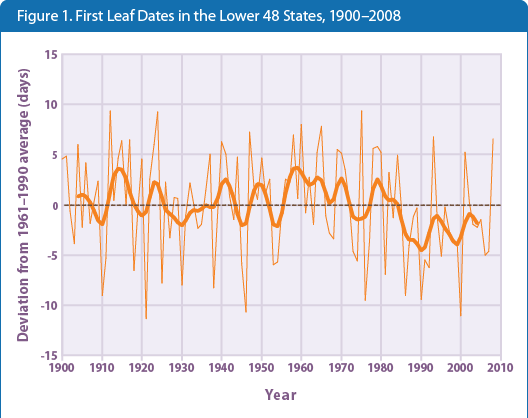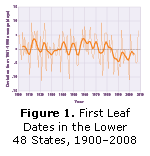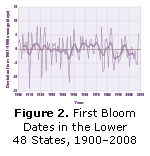Climate Change
Climate Change Indicators in the United States

This figure shows modeled trends in lilac and honeysuckle first leaf dates across the lower 48 states, using the 1961 to 1990 average as a baseline. Positive values indicate that leaf growth began later in the year, and negative values indicate that leafing occurred earlier. The thicker line was smoothed using a nine-year weighted average. Choosing a different long-term average for comparison would not change the shape of the trend.
Data source: Schwartz, 2009 4

This figure shows modeled trends in lilac and honeysuckle bloom dates across the lower 48 states, using the 1961 to 1990 average as a baseline. Positive values indicate that blooming occurred later in the year, and negative values indicate that blooming occurred earlier. The thicker line was smoothed using a nine-year weighted average. Choosing a different long-term average for comparison would not change the shape of the trend.
Data source: Schwartz, 2009 5
Key Points
- First leaf growth in lilacs and honeysuckles in the lower 48 states is now occurring a few days earlier than it did in the early 1900s. Although the data show a great deal of year-to-year variability, a noticeable change seems to have begun around the 1980s (see Figure 1).
- Lilacs and honeysuckles are also blooming slightly earlier than in the past. However, the data show a high degree of year-to-year variability, which makes it difficult to determine whether this change is statistically meaningful (see Figure 2).
- Other studies have looked at trends in leaf and bloom dates across all of North America and the entire Northern Hemisphere. These other studies have also found a trend toward earlier spring events, and many of these trends are more pronounced than the trends seen in just the lower 48 states. 3
Background
The timing of natural events, such as flower blooms and animal migration, is influenced by changes in climate. Phenology is the study of such important seasonal events. Phenological events are influenced by a combination of climate factors, including light, temperature, rainfall, and humidity.
Scientists have very high confidence that recent warming trends in global climate are linked to an earlier arrival of spring events. 1 Disruptions in the timing of these events can have a variety of impacts on ecosystems and human society. For example, an earlier spring might lead to longer growing seasons (see the Length of Growing Season indicator), more abundant invasive species and pests, and earlier and longer allergy seasons.
Because of their close connection with climate, the timing of phenological events can be accurate indicators of climate change. Some phenological indicators cover broad trends, such as overall "leaf-on" dates (when trees grow new leaves in the spring), using a combination of satellite data and ground observations. Others rely on ground observations that look at specific types or species of plants or animals. Two particularly useful indicators of the timing of spring events are the first leaf date and the first bloom date of lilacs and honeysuckles, which have an easily monitored flowering season, relatively high survival rate, and large geographic distribution. The first leaf date in these plants relates to the timing of "early spring," while the first bloom date is consistent with the timing of later spring events such as the start of growth in forest vegetation. 2
About the Indicator
This indicator shows trends in the timing of first leaf dates and first bloom dates in lilacs and honeysuckles across much of the lower 48 states (see map at right). Because many of the phenological observation records in the United States are less than 20 years long, models have been used to provide a more complete understanding of long-term trends.
The models for this indicator were developed using data from the USA National Phenology Network, which collects ground observations from a network of federal agencies, field stations, educational institutions, and citizen scientists who have been trained to log observations of leaf and bloom dates. For consistency, observations were limited to a few specific types of lilacs and honeysuckles. Next, models were created to relate actual leaf and bloom observations with records from nearby weather stations. Once scientists were able to determine the relationship between leaf and bloom dates and climate factors (particularly temperatures), they used this knowledge to estimate leaf and bloom dates for earlier years based on historical weather records.
This indicator uses data from several hundred weather stations throughout the area where lilacs and honeysuckles grow. The exact number of stations varies from year to year. For each year, the timing of first leaf and first bloom at each station was compared with the 1961 to 1990 average to determine the number of days' "deviation from normal." This indicator presents the average deviation across all stations.
Indicator Confidence
Plant phenological events are studied using several data collection methods, including satellite images, models, and direct observations. The use of varying data collection methods in addition to the use of different phenological indicators (such as leaf or bloom dates for different types of plants) can lead to a range of estimates of the arrival of spring.
Climate is not the only factor that can affect phenology. Observed variations can also reflect plant genetics, changes in the surrounding ecosystem, and other factors. This indicator minimizes genetic influences by relying on cloned plant species (that is, plants with no genetic differences).
Data Sources
Leaf and bloom observations were compiled by the USA National Phenology Network and are available at: www.usanpn.org. This indicator is also based on climate data that were provided by the U.S. Historical Climatology Network and are available at: www.ncdc.noaa.gov/oa/climate/ research/ushcn. Data for this indicator were analyzed using methods described by Schwartz et al. (2006). 6
Indicator Documentation
- Download related technical information PDF (7 pp, 48K)




